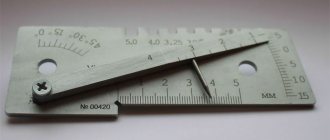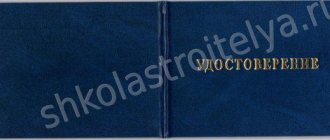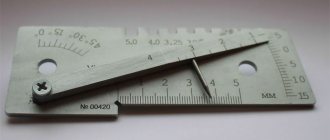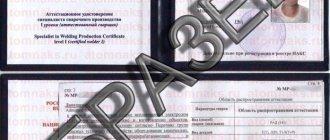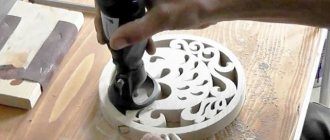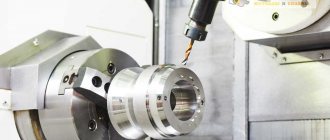A welder's template is a tool that allows a worker to control the geometric parameters of a weld, and also, in some cases, check the preparation of edges for welding and other characteristics. Template measurements are a visual method that is part of any welder's job. It is necessary not only to weld the part, but also to check the size of the leg and the absence of defects (lack of penetration, undercut, etc.).
In practice, welders rarely use templates, since professionals in their field usually determine all the necessary characteristics of a seam without a special measuring tool. However, the template will be a useful thing for novice welders to understand the basics of welding and acquire skills that will later allow a person to become a specialist who has knowledge and understanding of basic issues, and not just poking an electrode into the metal. The template can be useful for students of vocational schools, quality control department employees, it may be required for certification, and the tool can also be used by a wide range of interested parties (again, for educational purposes).
Welder templates differ from each other both in appearance and have functional differences. Let's look at some of them in more detail.
UShS-3
What can this instrument measure?
- Bevel angle The image shows a one-sided bevel of the edges. The template is installed on the part, and the arrow is rotated at an angle, which in our case is 45o.
- Blurring edges
Measured using the lower scale.
This way you can also determine the thickness of the metal.
- Gap between parts
It is measured using a scale in the form of a wedge that is placed in the gap. In our case, the gap is approximately 3.5 mm.
- Seam width
- Seam height
Determined by inserting a needle. Using the appropriate scale, we determine the reinforcement of the seam. Using the same method, you can measure the drop between rollers and check the “difference in thickness” of the parts.
By the upper grooves you can find out the diameter of the electrode (4-2 mm) or wire for semi-automatic welding (1-1.2 mm).
The disadvantages of this template include the impossibility of measuring the suture leg; for this you will have to buy an additional cathetomer.
Welder templates
Transition smoothness meter.
Intended for determining the legs of fillet welds in the range of 4 -14 mm.
It is used to control the quality of welds and allows you to determine the parameters of defects such as nicks, gaps, bluntings, bevel angles and excess edges.
A tool that combines the functions of the UShS-3 and Usherov-Marshak templates.
Designed to control weld legs during manual electric arc welding.
Weld joint meter.
Allows you to examine surfaces for misalignment, measure legs and rollers, and undercuts.
Measures edge offset, bevel size and weld width, butt weld reinforcement height, etc.
Used to measure the relative position of surfaces, the gap between pipes and different surfaces.
Provides control of all basic parameters of welds and workpieces.
Provides control of all basic parameters of welds and workpieces.
Provides control of all basic parameters of welds and workpieces.
Designed for measuring the bevel of edges when preparing welded joints, measuring the height of the reinforcement bead and fillet weld leg, etc.
Designed for measuring the bevel of edges when preparing welded joints, measuring the height of the reinforcement bead and fillet weld leg, etc.
Designed for measurements during welding of the bevel angle, pipe wall thickness, internal misalignment, weld reinforcement height, fillet weld leg, and gap when assembling parts for welding.
Designed to control the legs of fillet welds in the range of 3-25 mm.
Universal meter for welded joints.
Universal weld size meter.
Fillet weld parameter meter.
Universal weld gauge with reading window.
Template for measuring pipe pits.
Designed for measuring the height of rivets, welds on pressure vessels and pipes, etc.
Used to control the parameters of corner and T-joints welded at an angle greater or less than 90°.
Gap meter in the range of measured holes 0-15 mm.
Gap meter in the range of measured holes 15-30 mm.
Gap meter in the range of measured holes 30-45 mm.
Gap meter in the range of measured holes 45-60 mm.
A device for measuring the depth of undercut and incomplete filling of an indicator-type edge groove.
A device for measuring edge offsets and undercut depths.
Designed to determine the smoothness of the transition from the weld bead to the base metal.
Designed to determine the smoothness of the transition from the weld bead to the base metal.
Usherov-Marshak pattern
You can see how it is used in the picture. The size of the cut is 60°. Accordingly, each side is 30°.
In addition to the angle, you can measure the bluntness of the edges, the height of the reinforcement, the amount of convexity - “convexity” (not to be confused with the leg).
The width of the seam can be determined approximately. You can also measure the depth of defects: inter-roller depression, undercut, lack of fusion of edges.
Source: MastakSvarka
What is a welder template?
Welding work is a whole complex of activities that is subject to special control by flaw detection services, the purpose of which is to prevent negative consequences caused by poor-quality welding of butt joints on pipelines and other welded structures.
There are many methods of non-destructive testing of welding work, both at the stage of incoming inspection and at the stage of ready-made welded joints and surfacing. Here we can highlight:
— visual inspection method.
In this case, 100% of all welded joints are subjected to visual inspection.
Welder template
is a tool that is intended for visual inspection of welded joints.
There are many types of welder templates that differ from each other not only in design features, but also in the functions they perform. However, the most common templates are UShS-2, UShS-3 and UShS-4, as well as UShK-1 (Krasovsky template).
1) Universal welder template UShS-2
, also called a cathetometer, is intended for determining the legs of fillet welds in the range from 4 to 14 mm. UShS-2 is manufactured in accordance with STB 1133-98 “Welded joints. Method of control by external inspection and measurements. General requirements". At the same time, the legs of the welds are controlled by the method of stepwise selection of the appropriate angle of the leg on UShS-2 from the maximum to the minimum gap.
Figure 1. Universal welder template UShS-2
Structurally, UShS-2 consists of 3 metal plates connected to each other using a connecting ring. Each plate has recesses of a certain leg size, and each of these recesses is marked in accordance with the radius of the weld leg. By sequentially selecting plates with recesses relative to the surfaces connected by the weld, the leg of the weld is checked. The leg size is determined at the moment when the long side of the plate and the jumper between the legs of the plate are adjacent to the surfaces being welded without any visible gap, and the gap between the arc of the plate and the arc of the weld is minimal. In cases where not a single step of the size plate coincides with the weld, the value of the leg is determined empirically.
2) Universal welder template UShS-3
is intended for monitoring the measured parameters of pipes and pipelines, monitoring the condition of butt joints at the ends of pipes and pipelines, as well as visual monitoring of the quality of the weld during welding work. UShS-3 is also used before welding work: to control welding electrodes and weld preparation elements.
Figure 2. Universal welder template UShS-3.
UShS-3 is the main measuring instrument used for training future specialists in welding training centers; it is included in the list of mandatory equipment for visual inspection, and can be used at any enterprises and organizations where welding work is carried out.
Using UShS-3 you can make the following control measurements:
— Control and measurement of the dimensions of the weld (Figure 3), such as the height and width of the seam, the depth of the undercut, the amount of depression between the weld beads, etc.
Figure 3. Measurements using UShS-3: a - measurement of the height of the weld and the depth of the undercut; b - measurement of the width of the weld; c - measurement of depressions between weld beads.
— Measuring the displacement (bevels) of the outer edges of parts (Figure 4.)
Figure 4. Measuring the displacement of the outer edges of parts
— Measuring gaps in connections (Figure 5);
Figure 5. Measuring joint clearances.
— Control of cutting bevel angles (Figure 6.)
Figure 6. Controlling the cutting bevel angle.
— Determination of the diameters of the wire and welding electrodes (using technological grooves on the upper side of the tool).
Universal welder templates UShS-3 are used both indoors and outdoors. After use, the template must be washed in gasoline and wiped with a soft cloth. The template must be stored in a clean, dry room, at a temperature from -45 to +45 o C. If the template has not been used for a year, it must be re-preserved in accordance with the requirements of GOST 9.014-78. At the same time, transportation of templates is allowed by all types of open transport.
3) Universal welder template USHS-4
– the most universal tool, which is intended for visual inspection of weld preparation elements, electrodes, bevel angles, height of the reinforcement bead and fillet weld leg, convexity of the root of the seam of a butt welded joint, as well as the size of the gap between the parts being welded (Figure 7.).
Welder templates
Welding work involves a wide range of activities aimed at creating strong, reliable connections of structures, parts, and elements. The trouble-free operation of the object, mechanism, and its safety for people and the environment depends on the implementation of these works. To prevent possible negative consequences caused by poorly performed work, welded joints and surfacing are subjected to strict flaw detection inspection both during their implementation and at the stage of final inspection, during the operation of pipelines and other structures.
What is a welder template?
During flaw detection, several different inspection methods are used:
- ultrasonic;
- radiographic;
- magnetographic;
- visual.
And if the first three testing methods require the use of special instruments and are not always carried out, then all welds and joints, without exception, are subject to visual inspection.
The process of performing a visual inspection involves the use of a special device - a welder's template . This is a specialized measuring tool that allows you to accurately and quickly determine the main parameters of a weld. To do this, you can use other tools, for example, a caliper. However, in this case, the process will be longer, more inconvenient, and the results obtained will be less reliable.
